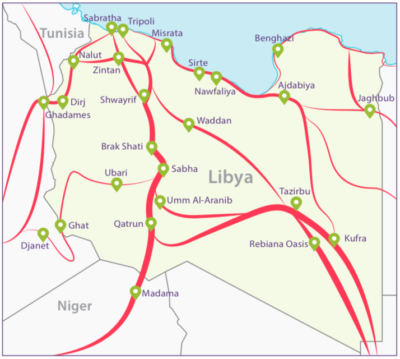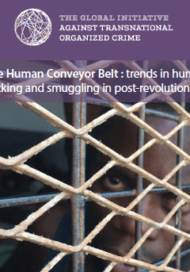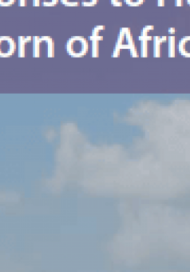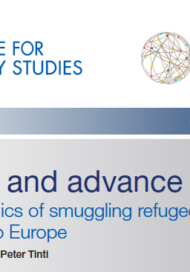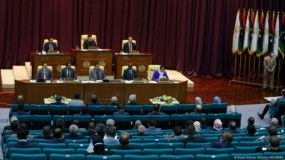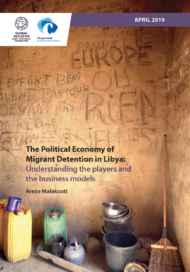Posted on 17 Mar 2017
The proliferation of human smuggling in Libya is both a criminal problem and a feature of Libya’s fracture into competing armed factions. Whilst most acutely perceived on Libya’s coast, it is in fact an illicit trade embedded across the country, encompassing and feeding on the political economy and geopolitics of Libya’s Southern, Eastern and Western borders.
The expansion and consolidation of smuggling activity has been further predicated on the interface with communities, as it has been justified as a means to fund militias, which in turn provide security in the face of external threats from competing families, tribes and towns.
Migrants and refugees have become simply another commodity to be exploited in the broader resource predation carried out by armed groups that exercise effective control over the Libyan territory. The consequences for human security, both for the migrants but for the Libyan people, are considerable.
Action is urgently needed but a long-term perspective is imperative. Any intervention by the international community or national Libyan agents that takes a short-term perspective risks playing into the hands of the very same armed groups at the heart of the problem. Not only would such action risk failing to achieve the stated goal of bringing order to migratory flows running through Libya, but may in fact contribute to the further destabilisation of the country.
The alternative is not inaction but greater investment in bridging the knowledge gaps with a view to identify ways in which to isolate smuggling industries from their communities at a local level.
In this most recent research report, author Mark Micallef, shares the contemporary dynamics in modern, post-revolution Libya, from a process of ongoing monitoring of key migratory nodes between January and December 2016, drawing from interviews and exchanges with more than 62 key informants across Libya, Egypt, Tunisia, Sudan, Malta, Italy and Brussels, which include Libyan and European politicians, diplomats, security sources, activists as well as brokers and smugglers involved in various trades. The report uniquely benefits from four extensive face-to-face interviews with human smugglers operating in the greater Tripolitania area and 54 surveys carried out with people rescued off Libya between June and July, as well as 15 in-depth exchanges with migrants and refugees over a prolonged engagement lasting more than a year, in the case of two of the respondents.
Key Findings
- Market Liberalisation: The liberalisation of the human smuggling market in the immediate aftermath of Libya’s revolution provided established smugglers with new opportunities to internationalise their network with the help of Middle Eastern and East African middlemen and better access to hawala(paperless financial transactions based on honour)– an activity that was closely monitored by the Qaddafi regime. While coastal linchpins had enjoyed long established relationships with East African manadeeb (plural of mandub, agent or representative), these contacts were furthered during this period. Moreover, the advent of Syrian refugees seeking to cross to Europe from Libya opened new opportunities to develop a financial infrastructure which was fundamental for the development of the smuggling industry in the following years.
- Smuggling as Resource Predation: The protection market developed by various militias and armed groups around smuggling is a feature of the general resource predation which has come to characterise Libya’s socio-political landscape after the revolution. This interfaces the activity with local familial, tribal and community interests, resulting in some instances in the perception of legitimacy of smuggling, or at the very least the view that such activities are a necessary evil for the provision of a community’s security in the face of outside threats from competing or antagonist groups.
- Capacity Expansion: The involvement of militias in the smuggling process both through the taxing of activities in their territory and the direct running of human smuggling networks has reshaped the market which can no longer be described as a liberalised market. The rules of supply and demand cannot be applied directly to the analysis of human smuggling and trafficking in Libya anymore because access to protection is what ultimately guarantees a network’s position in the market place. The militarisation of the activity is squeezing small-timers out of the business and concentring smuggling activities in the hands of fewer, well-organised criminal networks. The territorial access provided by militias has expanded smugglers logistical capacity and further increased efficiency, opening the Libyan territory to a lot more “business”, particularly in the context of a seemingly limitless demand. It is this enhanced capacity that has led to the explosion in numbers seen in the aftermath of the revolution, especially after 2013.
- Transnational consolidation: There are clear signs some networks have developed into transnational consortia, able to handle routes and volumes of people requiring substantial logistical and financial capacity. Of particular relevance is the fact that different networks are sharing facilities. This is a new phenomenon to the Libyan context, which has substantial implications for policy formulation. While, Diaspora networks from the Middle East and North Africa (MENA) and sub-Sahara regions have long operated over huge geographies requiring coordination in multiple countries and different parts of Libya, such coordination was mostly confined to the supply side. Each of these networks would make its own arrangements with different players in Libya (desert guides/transit smugglers/ coastal smugglers). That coordinating role now appears to have been taken over – at least on some routes – by Libyan linchpins who are able to guarantee access to multiple territories.
